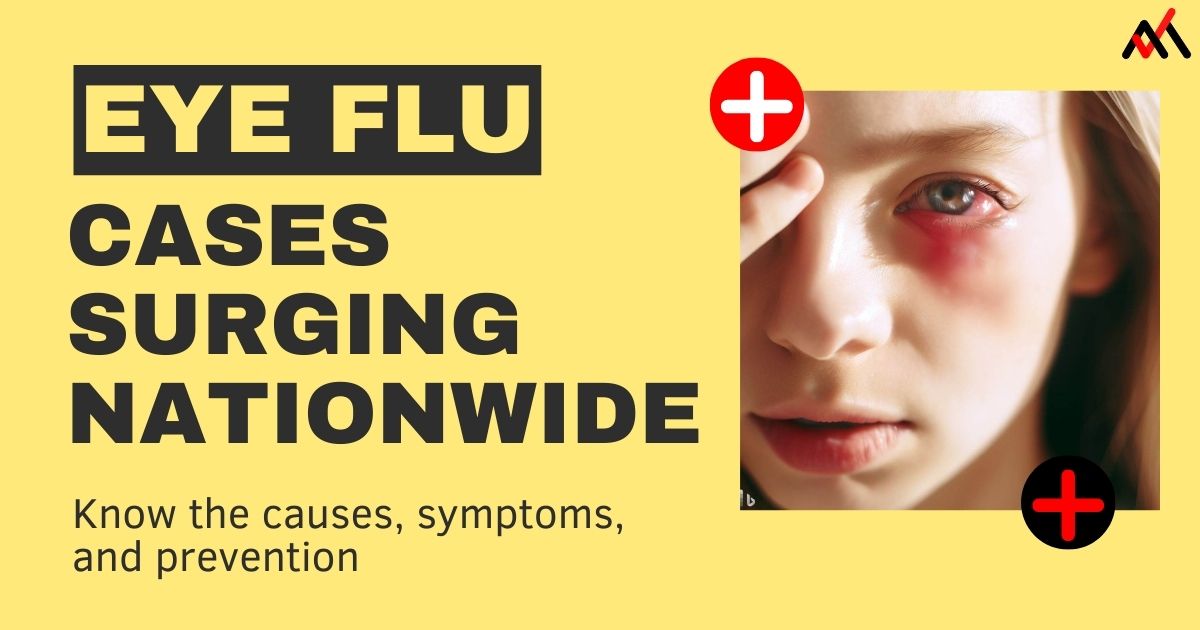As the monsoon season descends upon the country, it brings much-needed relief from the scorching heat, but also ushers in a host of infections and diseases. Among the common monsoon-related ailments, eye flu, also known as conjunctivitis, has emerged as a frequent concern from the bustling streets of Delhi to the coastal cities of Mumbai, and even the serene landscapes of Arunachal Pradesh. With a concerning rise in eye flu cases, health authorities are taking measures to curb the spread and educate the public about preventive measures.
Conjunctivitis is an eye infection that can cause redness, itchiness, and discharge in the eyes. Affected individuals may experience difficulty opening their eyes in the morning due to the formation of crust over the eyelids. Swollen eyes and sensitivity to light are also common symptoms of this contagious condition.
While it can be caused by viral or bacterial infections, it can also be triggered by allergies. Fortunately, conjunctivitis typically does not affect vision, and the eyes usually recover completely once the infection has been treated or has run its course.
Arunachal Pradesh, in particular, has witnessed a surge in eye flu cases, leading to the temporary closure of schools in various districts. The highly contagious nature of the disease has prompted authorities to take swift action to prevent further transmission. Conjunctivitis spreads rapidly, especially in the case of viral or bacterial infections.
To minimize the risk of contracting or spreading eye flu, health experts advise maintaining good hygiene practices, such as frequent handwashing, avoiding touching the eyes, and refraining from sharing personal items like towels or eye makeup.
Page Index
Symptoms of Eye Flu
As the monsoon season takes hold, eye flu, or conjunctivitis, emerges as a prevalent health concern across the country. Common symptoms of eye flu include:
- Redness and inflammation of the eyes
- Itching and irritation in the eyes
- Watery or sticky discharge from the eyes
- Sensitivity to light
- Swelling of the eyelids
- Crust formation on the eyelids, especially in the morning
- Blurred vision (rarely)
Treatment and Recovery
The treatment for eye flu depends on its cause. Here are the different approaches based on the type of conjunctivitis:
- Viral Conjunctivitis:
- Viral conjunctivitis is the most common type and usually resolves on its own within one to two weeks.
- Artificial tears or eye drops can help alleviate discomfort and keep the eyes lubricated.
- Applying a cold compress to the eyes can provide relief from inflammation and soothe irritation.
- Bacterial Conjunctivitis:
- Bacterial conjunctivitis may require antibiotic eye drops or ointments prescribed by a doctor to eliminate the infection.
- Completing the full course of antibiotics is crucial to prevent the recurrence of the infection.
- Allergic Conjunctivitis:
- Allergic conjunctivitis can be managed by using antihistamine eye drops to reduce inflammation and itching.
- Avoiding exposure to allergens can help prevent flare-ups.
Home Remedies for Eye Flu
While seeking professional medical advice is essential for treating eye flu, there are some effective home remedies that can provide relief from discomfort and support the recovery process. Here are a few tried and tested home remedies:
- Cold Compress
- Warm Chamomile Tea Bags
- Cucumber Slices
- Aloe Vera Gel
- Honey Water
- Rose Water
- Potato Poultice
Remember, these home remedies can provide temporary relief but should not replace medical advice. If the symptoms persist or worsen, it is essential to consult an eye care specialist for proper diagnosis and treatment. By being vigilant and taking necessary precautions, we can protect our eyes during this challenging time and ensure a healthier monsoon season for everyone.
Contagion and Prevention
Conjunctivitis is highly contagious, spreading rapidly among individuals, especially in crowded areas or close contacts. To prevent the spread of eye flu, it is crucial to take the following preventive measures:
- Maintain good hygiene, wash hands frequently with soap and water, especially after touching the eyes or coming into contact with an infected person.
- Avoid touching or rubbing the eyes, as it can transfer the infection from the hands to the eyes or from one eye to the other.
- Refrain from sharing personal items like towels, pillowcases, or eye makeup with others to prevent cross-contamination.
- Minimize exposure to contaminated water during the monsoon season, as it may contain harmful bacteria.
- Wear sunglasses to protect the eyes from harmful UV rays and reduce exposure to allergens, thus preventing allergic conjunctivitis.
- Keep living areas clean and dust-free to reduce the presence of allergens and irritants that can trigger eye flu.
- Practice social distancing during an outbreak to avoid direct exposure to infected individuals.
As the number of cases increases, experts are also recommending several home remedies to alleviate discomfort and irritation caused by eye flu. While viral conjunctivitis usually resolves on its own within a week or two, bacterial conjunctivitis may require antibiotic eye drops or ointments prescribed by a doctor. For those suffering from allergic conjunctivitis, antihistamine eye drops or avoiding allergens can help manage the condition.
By following these preventive measures and promoting public awareness, we can collectively curb the spread of eye flu and ensure a healthier and more enjoyable monsoon season for everyone. If anyone experiences persistent symptoms, it is vital to consult an eye specialist for proper diagnosis and treatment. Remember, safeguarding our eyes is key to maintaining overall health and well-being.
To combat the spread of eye flu, it is essential to avoid direct contact with rainwater or any contaminated water sources during the monsoon season. Wearing sunglasses can provide additional protection against harmful UV rays and reduce exposure to allergens, thus preventing the onset of allergic conjunctivitis. Ensuring a clean and dust-free living environment is also crucial in minimizing the risk of infection.
To address the growing concern, health authorities are actively promoting public awareness campaigns through various mediums, including television, radio, and social media. These campaigns aim to educate the public about the symptoms, prevention, and proper hygiene practices to adopt during this vulnerable period.
In conclusion, as the monsoon season unfolds, the rise in eye flu cases presents a significant public health challenge across the country. Vigilance, timely reporting, and adherence to preventive measures are paramount in curbing the spread of this highly contagious condition. By working together and prioritizing our eye health, we can ensure a healthier and safer monsoon season for all.


